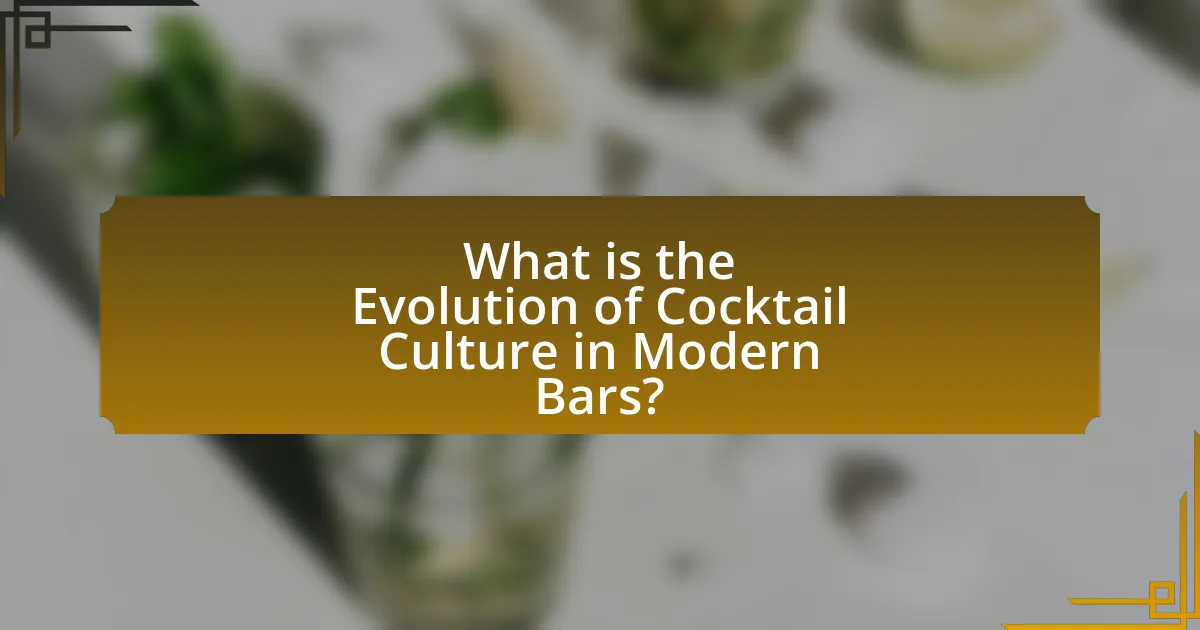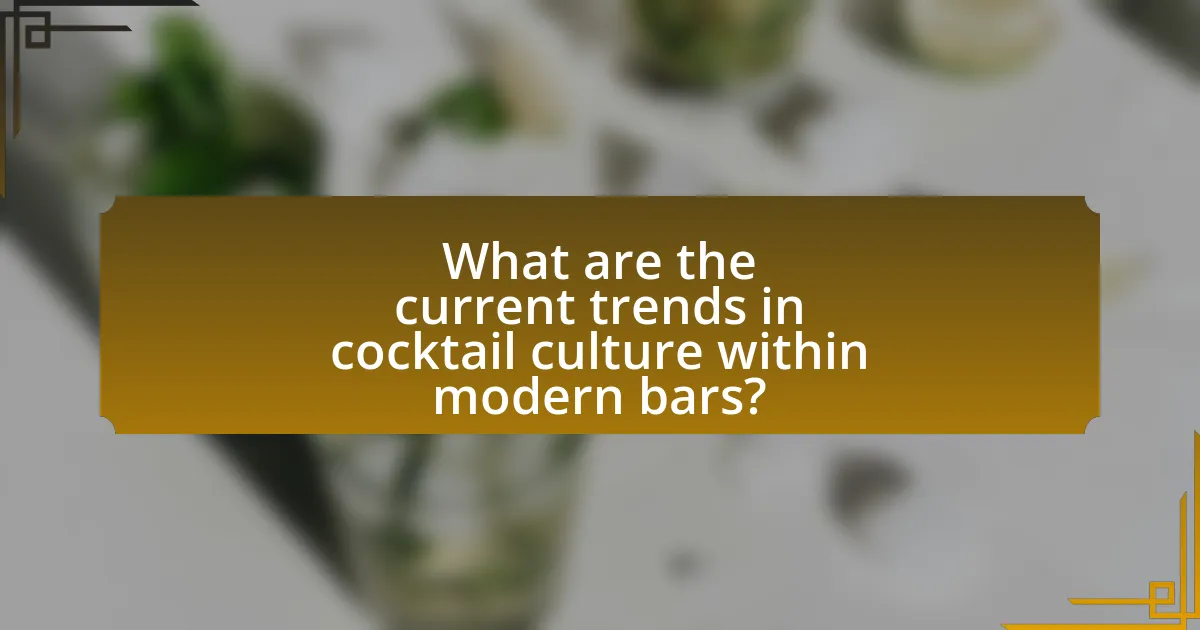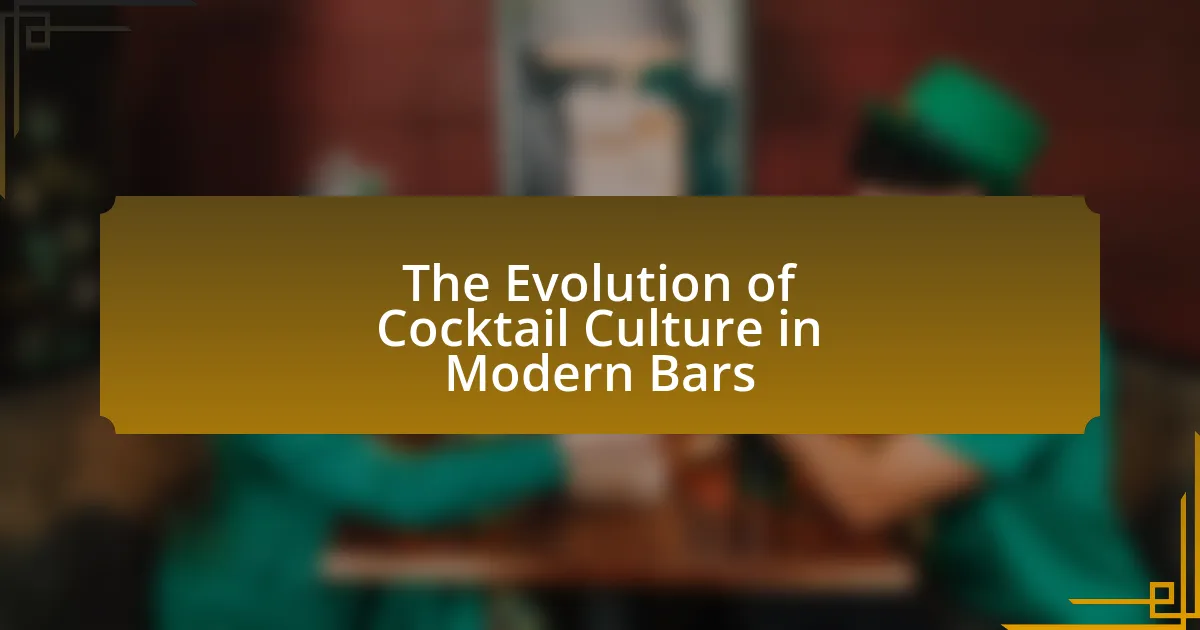The article examines the evolution of cocktail culture in modern bars, highlighting its transformation from simple mixed drinks to a sophisticated art form characterized by craft cocktails and innovative ingredients. It traces the historical influences on cocktail culture, including Prohibition and globalization, and discusses the rise of craft cocktail bars and the impact of social media on trends and presentation. Key characteristics of modern cocktail culture, such as the emphasis on quality ingredients, sustainability, and experiential drinking, are explored, along with current trends and popular cocktail styles. The article also addresses the role of mixology and innovative techniques in shaping contemporary cocktail experiences.

What is the Evolution of Cocktail Culture in Modern Bars?
The evolution of cocktail culture in modern bars has transitioned from simple mixed drinks to a sophisticated art form characterized by craft cocktails, innovative ingredients, and a focus on presentation. This shift began in the late 20th century, particularly during the cocktail renaissance of the 2000s, when bartenders started to emphasize quality, technique, and creativity, often drawing inspiration from historical recipes and global influences.
The rise of craft cocktail bars, such as PDT in New York and The Dead Rabbit, has played a significant role in this evolution, showcasing artisanal spirits, house-made syrups, and fresh ingredients. Additionally, the use of molecular gastronomy techniques and unique flavor pairings has further transformed the cocktail experience, appealing to a more discerning clientele.
Statistics indicate that the craft cocktail movement has led to a significant increase in cocktail sales, with the global cocktail market projected to reach $1.6 billion by 2025, reflecting the growing popularity and sophistication of cocktail culture in modern bars.
How has cocktail culture changed over the decades?
Cocktail culture has evolved significantly over the decades, transitioning from simple mixed drinks to complex, artisanal creations. In the 1920s and 1930s, during Prohibition in the United States, cocktails were often masked with strong flavors to hide the taste of poorly made spirits. The 1950s and 1960s saw the rise of tiki culture, characterized by fruity, rum-based drinks served in elaborate glassware. By the 1980s and 1990s, the cocktail scene began to shift towards a focus on quality ingredients and classic recipes, influenced by the resurgence of craft bartending. The 2000s introduced a new wave of cocktail culture, emphasizing local ingredients, innovative techniques, and a revival of forgotten recipes, as seen in the popularity of craft cocktail bars. This evolution reflects broader trends in gastronomy and consumer preferences for authenticity and craftsmanship in food and drink.
What historical events influenced the evolution of cocktail culture?
The evolution of cocktail culture has been significantly influenced by several historical events, including Prohibition in the United States from 1920 to 1933. During this period, the production and sale of alcoholic beverages were banned, leading to the rise of speakeasies where cocktails were often the drink of choice, fostering creativity in mixology. Additionally, the post-World War II era saw an increase in international travel and cultural exchange, which introduced new ingredients and techniques, further diversifying cocktail recipes. The craft cocktail movement that began in the late 20th century emphasized quality ingredients and artisanal methods, reflecting a shift towards a more sophisticated drinking culture. These events collectively shaped the modern cocktail landscape, establishing a rich tradition that continues to evolve today.
How did Prohibition impact cocktail culture in the United States?
Prohibition significantly transformed cocktail culture in the United States by driving the creation and popularization of speakeasies, where illicit drinking occurred. During the 1920s, the ban on alcohol led to a surge in demand for creative cocktails as bartenders sought to mask the taste of poorly made, bootlegged spirits. This era saw the rise of classic cocktails like the Martini and the Sidecar, which became symbols of sophistication and rebellion against the restrictive laws. The need for inventive recipes and presentation in clandestine bars contributed to the evolution of cocktail culture, establishing a foundation that continues to influence modern mixology.
What are the key characteristics of modern cocktail culture?
Modern cocktail culture is characterized by a focus on craft, creativity, and quality ingredients. This culture emphasizes artisanal techniques, where bartenders often act as mixologists, showcasing their skills through innovative recipes and presentation. The use of fresh, locally sourced ingredients is prevalent, reflecting a trend towards sustainability and health consciousness. Additionally, modern cocktail culture embraces a diverse range of flavors and influences, often incorporating global spirits and unique garnishes. The rise of cocktail bars as social hubs further highlights the importance of ambiance and experience in this culture, with many establishments prioritizing design and customer engagement. This evolution is supported by the increasing popularity of cocktail competitions and the proliferation of cocktail-focused literature and media, which educate both consumers and professionals about the art of mixology.
How do contemporary bars differ from traditional cocktail bars?
Contemporary bars differ from traditional cocktail bars primarily in their approach to mixology and ambiance. Contemporary bars often emphasize innovative cocktails that incorporate unique ingredients and techniques, such as molecular gastronomy, while traditional cocktail bars typically focus on classic recipes and established techniques. For example, contemporary bars may use sous-vide methods or infusions to create distinctive flavors, whereas traditional bars rely on time-honored drinks like the Martini or Old Fashioned. This shift reflects a broader trend in the cocktail culture, where creativity and experimentation are prioritized, leading to a more dynamic and diverse drinking experience.
What role does mixology play in modern cocktail culture?
Mixology plays a central role in modern cocktail culture by elevating the craft of cocktail preparation to an art form that emphasizes creativity, precision, and innovation. This discipline involves not only the mixing of ingredients but also the understanding of flavor profiles, techniques, and presentation, which collectively enhance the overall drinking experience. For instance, the rise of craft cocktails has led to a significant increase in the use of fresh ingredients, artisanal spirits, and unique garnishes, reflecting a shift towards quality and personalization in beverage service. According to the 2021 “Cocktail Culture” report by the National Restaurant Association, 70% of consumers are more likely to order a cocktail if it features unique ingredients or a creative presentation, underscoring the importance of mixology in attracting modern patrons.

What factors have contributed to the rise of cocktail culture in modern bars?
The rise of cocktail culture in modern bars is primarily driven by the increasing consumer demand for unique and artisanal drinking experiences. This trend is supported by the craft cocktail movement, which emphasizes high-quality ingredients, innovative techniques, and presentation. According to a report by the Distilled Spirits Council, the craft cocktail segment has seen significant growth, with sales increasing by 20% from 2015 to 2020, reflecting a shift in consumer preferences towards more sophisticated and personalized beverage options. Additionally, the influence of social media platforms has amplified the visibility of cocktail culture, allowing bars to showcase their creations and attract a wider audience.
How has globalization affected cocktail trends?
Globalization has significantly influenced cocktail trends by facilitating the exchange of diverse cultural practices and ingredients across borders. This exchange has led to the incorporation of international flavors and techniques into cocktail recipes, resulting in a fusion of styles that reflect a global palate. For instance, the rise of tiki cocktails in the United States drew inspiration from Polynesian culture, while the popularity of mezcal and sake cocktails showcases the integration of Mexican and Japanese spirits into mainstream bar menus. Additionally, the accessibility of global ingredients, such as exotic fruits and artisanal spirits, has expanded the creativity and variety of cocktails available, making them more diverse and appealing to a wider audience.
What international influences can be seen in modern cocktail recipes?
Modern cocktail recipes exhibit significant international influences, particularly from regions such as Latin America, Asia, and Europe. For instance, the use of ingredients like tequila and mezcal in cocktails reflects the Mexican influence, while Asian flavors, such as yuzu and sake, have become popular in contemporary mixology. Additionally, European classics, like the Negroni and the Martini, continue to inspire modern variations, showcasing the enduring impact of traditional recipes. This blending of global flavors and techniques illustrates the dynamic nature of cocktail culture, as bartenders increasingly draw from diverse culinary traditions to create innovative drinks.
How do cultural exchanges shape cocktail ingredients and techniques?
Cultural exchanges significantly shape cocktail ingredients and techniques by introducing diverse flavors, methods, and traditions from various regions. For instance, the incorporation of Japanese precision in cocktail crafting has influenced bartenders worldwide to adopt meticulous techniques, such as the use of jiggers for precise measurements. Additionally, the globalization of ingredients, such as the use of mezcal from Mexico or sake from Japan, has expanded the flavor profiles available in cocktails, allowing for innovative combinations that reflect a fusion of cultural influences. Historical examples include the introduction of the Daiquiri from Cuba to the United States, which led to the popularization of rum-based cocktails in American bars. This blending of cultural practices not only enriches the cocktail experience but also fosters creativity and experimentation among bartenders globally.
What role does social media play in the evolution of cocktail culture?
Social media significantly influences the evolution of cocktail culture by facilitating the sharing of cocktail recipes, trends, and experiences among users. Platforms like Instagram and TikTok allow bartenders and enthusiasts to showcase visually appealing cocktails, which drives creativity and innovation in drink preparation. For instance, the hashtag #Cocktail has millions of posts, indicating widespread engagement and interest in cocktail culture. This visibility encourages bars to experiment with unique ingredients and presentation styles to attract social media attention, ultimately shaping consumer preferences and industry standards.
How has Instagram changed the way cocktails are presented and marketed?
Instagram has transformed cocktail presentation and marketing by prioritizing visually appealing aesthetics and shareable content. The platform encourages bars and restaurants to create vibrant, photogenic cocktails that attract customers’ attention, leading to increased social media engagement. According to a study by the National Restaurant Association, 30% of consumers reported being influenced by social media when choosing dining experiences, highlighting the impact of Instagram on consumer behavior. Additionally, the rise of hashtags and influencer partnerships has enabled brands to reach wider audiences, further enhancing the visibility and desirability of unique cocktail offerings.
What impact do online cocktail communities have on trends and innovations?
Online cocktail communities significantly influence trends and innovations in the cocktail industry by facilitating knowledge sharing and fostering creativity among enthusiasts and professionals. These platforms enable users to exchange recipes, techniques, and experiences, leading to the rapid dissemination of new ideas and trends. For instance, the rise of craft cocktails and unique flavor combinations can be traced back to discussions and collaborations within these online spaces, where members experiment and showcase their creations. Additionally, data from platforms like Instagram and Reddit show that viral cocktail recipes often originate from community interactions, demonstrating the direct impact of these online networks on consumer preferences and industry practices.

What are the current trends in cocktail culture within modern bars?
Current trends in cocktail culture within modern bars include a focus on sustainability, craft ingredients, and experiential drinking. Bars are increasingly sourcing local and organic ingredients to minimize environmental impact, with 60% of bartenders reporting a commitment to sustainability in a 2022 industry survey. Additionally, the use of artisanal spirits and house-made mixers has surged, reflecting a demand for unique flavor profiles and authenticity. The rise of interactive cocktail experiences, such as DIY cocktail kits and immersive tasting events, further illustrates the shift towards engaging patrons in the cocktail-making process, enhancing the overall drinking experience.
What innovative techniques are being used in cocktail preparation today?
Innovative techniques in cocktail preparation today include molecular mixology, which utilizes scientific principles to create unique textures and flavors, such as foams and gels. Techniques like sous-vide infusion allow bartenders to extract flavors from ingredients at precise temperatures, enhancing the overall taste profile. Additionally, the use of carbonation systems enables the creation of sparkling cocktails with controlled fizziness. These methods are supported by the growing trend of craft cocktails, where precision and creativity are paramount, as evidenced by the rise of cocktail competitions and the influence of culinary techniques in mixology.
How does molecular mixology redefine traditional cocktail making?
Molecular mixology redefines traditional cocktail making by incorporating scientific techniques and innovative ingredients to enhance flavor, texture, and presentation. This approach utilizes methods such as spherification, foaming, and the use of liquid nitrogen, allowing bartenders to create unique sensory experiences that traditional methods cannot achieve. For example, spherification transforms liquids into caviar-like spheres that burst with flavor, while foams can add aromatic elements to cocktails. These techniques not only elevate the aesthetic appeal of drinks but also engage customers in a more interactive and memorable drinking experience, reflecting a shift towards culinary artistry in cocktail culture.
What are the benefits of using local and seasonal ingredients in cocktails?
Using local and seasonal ingredients in cocktails enhances flavor, supports local economies, and promotes sustainability. Fresh, in-season produce often has superior taste and nutritional value, which can elevate the overall quality of the cocktail. For instance, fruits and herbs that are harvested at their peak ripeness provide more vibrant flavors compared to out-of-season alternatives. Additionally, sourcing ingredients locally reduces transportation emissions, aligning with sustainable practices that many modern bars prioritize. This approach not only fosters community relationships but also encourages a more responsible consumption model, as evidenced by the growing trend of farm-to-table practices in the beverage industry.
What are the most popular cocktail styles in modern bars?
The most popular cocktail styles in modern bars include classic cocktails, craft cocktails, and low-alcohol cocktails. Classic cocktails, such as the Old Fashioned and Martini, remain staples due to their historical significance and timeless appeal. Craft cocktails emphasize artisanal ingredients and innovative techniques, reflecting a trend towards personalization and creativity in mixology. Low-alcohol cocktails, often referred to as “session cocktails,” have gained popularity as consumers seek lighter options that allow for moderation without sacrificing flavor. This trend is supported by a growing awareness of health and wellness among patrons, leading to a shift in cocktail preferences.
Which classic cocktails have made a comeback in recent years?
Classic cocktails that have made a comeback in recent years include the Negroni, Old Fashioned, and Espresso Martini. The resurgence of these drinks is attributed to a growing interest in craft cocktails and a revival of traditional bartending techniques. For instance, the Negroni, originally created in the early 20th century, has gained popularity due to its balanced flavors and simplicity, often featured in cocktail bars focusing on artisanal ingredients. Similarly, the Old Fashioned, a staple since the 1800s, has seen renewed interest as bartenders emphasize whiskey and bitters, showcasing the drink’s classic roots. The Espresso Martini, which gained fame in the 1980s, has re-emerged as a favorite for its combination of coffee and vodka, appealing to modern tastes for both caffeine and cocktails.
How do craft cocktails differ from mass-produced options?
Craft cocktails differ from mass-produced options primarily in their preparation and ingredient quality. Craft cocktails are typically made with fresh, high-quality ingredients and often involve unique recipes that emphasize creativity and artisanal techniques. In contrast, mass-produced cocktails rely on pre-made mixes and lower-quality ingredients, resulting in a more standardized and less personalized drinking experience. The craft cocktail movement, which gained momentum in the early 2000s, emphasizes the use of local and seasonal ingredients, as well as the skill of the bartender, which enhances the overall flavor and presentation. This focus on craftsmanship and individuality is a key distinction that sets craft cocktails apart from their mass-produced counterparts.
What practical tips can enhance the cocktail experience in modern bars?
To enhance the cocktail experience in modern bars, patrons should engage with knowledgeable bartenders who can provide personalized recommendations based on individual preferences. This interaction not only fosters a deeper understanding of the cocktails but also allows for tailored experiences that align with the drinker’s taste. Additionally, exploring seasonal ingredients can elevate the flavor profile of cocktails, as fresh produce often leads to more vibrant and complex drinks. Research indicates that bars utilizing local and seasonal ingredients see increased customer satisfaction and repeat visits. Furthermore, participating in cocktail tastings or classes can deepen appreciation and knowledge of mixology, enriching the overall experience.
How can patrons choose the best cocktails based on their preferences?
Patrons can choose the best cocktails based on their preferences by identifying their taste profiles, such as sweetness, bitterness, or acidity, and exploring cocktails that align with those flavors. For instance, those who enjoy sweet flavors may prefer cocktails like Mojitos or Piña Coladas, while individuals who favor bitter notes might opt for Negronis or Manhattans. Additionally, patrons can consider the base spirit, such as vodka, gin, or whiskey, as this significantly influences the cocktail’s overall taste. Research indicates that understanding personal flavor preferences enhances the cocktail selection process, leading to more satisfying choices.
What should bartenders consider when creating a cocktail menu?
Bartenders should consider the balance of flavors, seasonal ingredients, and customer preferences when creating a cocktail menu. A well-crafted cocktail menu reflects a variety of taste profiles, ensuring that it caters to diverse palates. Seasonal ingredients not only enhance freshness but also align with current trends, as seen in the rise of farm-to-table concepts in the beverage industry. Additionally, understanding customer preferences through feedback and sales data can guide bartenders in selecting popular and innovative cocktails, ultimately leading to increased customer satisfaction and repeat business.
